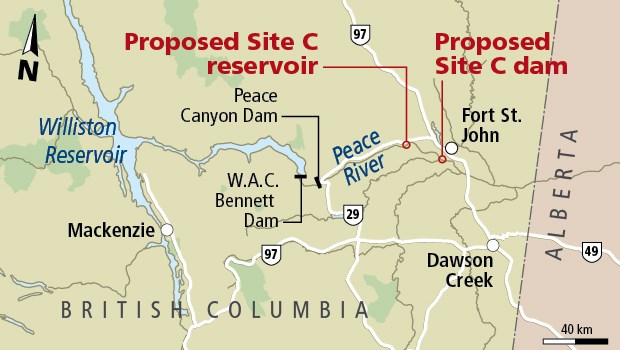B.C. Hydro says its proposed $7.9-billion Site C hydroelectric dam in northeastern British Columbia will flood agricultural land and force some landowners off their property, but overall, the project should proceed because it's in the best interests of the province.
The Crown-owned public utility submitted its environmental impact statement Monday to federal and provincial review bodies that must now conduct a joint environmental review process that includes public hearings and will be followed by a decision on the future of the project, likely sometime next year.
The massive, five-volume, 40-section submission to the federal Canadian Environmental Assessment Agency and the provincial British Columbia Environmental Assessment Office is the result of five years of studying the potential effects of the dam and proposed measures to avoid or mitigate the impacts.
"On the balance of it all, we believe that even looking at the things that can't be mitigated, that the project should move forward because it's in the best interest, we believe, for the province of British Columbia," said David Conway, Hydro's Site C community relations spokesman, who was in Fort St. John for the announcement.
"We feel the effects of the project can largely be mitigated through careful project planning and comprehensive mitigation programs and ongoing monitoring of operations," he said.
"But like any large infrastructure project there are things that can't be mitigated."
Hydro's Site C Clean Energy Project would be the third dam and hydroelectric generating station on the Peace River in B.C.'s northeast. Site C will be about one-third of the size of the area's W.A.C. Bennett Dam.
Hydro energy forecasts indicate customer demand for electricity is expected to increase by about 40 per cent over the next 20 years. Site C is projected to supply enough energy to power 465,000 homes for 100 years.
But Site C, with its 83-kilometre-long reservoir and earth dam, comes with impacts, including flooding at least 3,800-hectares of agricultural land and realigning Highway 29 from Hudson's Hope to Fort St. John, which means at least 20 family moves, said Conway.
"There are approximately 100 land holdings, which is not people, affected in some way in some aspect by the project," he said.
Of the 100 pieces of land, there are 30 homes, said Conway. He said Hydro's environmental impact study concludes the Site C project will force 10 to move out of the area, 10 others to move to other areas on their own property and 10 other homes won't need to be moved.
Conway said Hydro will offer compensation to the land holders.
B.C. Hydro is also in negotiations with area First Nations who must be consulted about the project and in some cases be accommodated, said Conway.
He said Hydro has approached 50 First Nations in the area, including groups in Alberta and along the borders of Saskatchewan and Northwest Territories.
So far, Hydro has 13 compensation agreements with 16 aboriginal groups and is in talks with 29 others, Conway said.
Hudson's Hope cattle rancher Leigh Summer said locals were not aware that Hydro submitted its environmental impact statement Monday.
Summer, 62, said he's lived in the area all his life and is hoping, like many area residents, that the environmental review turns down Site C.
"If they do a proper assessment of what's going to happen there, I say environmental review boards would be remiss to allow it to go ahead because of the mess it's going to make," he said.
Summer said he's concerned that Hydro's plans won't hold back the water, leading to erosion.
"To say that they can mitigate or stop the sloughing, they're full of (crap)," he said. "When you subject those riverbanks to 100 feet of water, they're going to slide in because this whole riverbank moves all the time and it's going to make a helluva mess."
B.C.'s energy, mines and natural gas minister Rich Coleman said the Site C proposal would create more than 30,000 jobs and provide clean energy for decades.
"Reliable, dependable electricity is critical to British Columbia’s economy and quality of life," he said in a statement. "The development and construction of Site C is expected to create approximately 33,000 jobs and contribute $3.2 billion to provincial GDP."
Opposition New Democrat energy critic John Horgan said the Site C environmental impact statement is premature because B.C. does not have a complete understanding of its energy needs.
"So this report, these findings, come down to really add more fog than clarity to our long-term energy needs," he said.
Horgan said the NDP wants more understanding of the province's future energy situation before undertaking a multi-billion project like Site C.
Former premier Gordon Campbell announced in April 2010 that the on-again, off-again project was going ahead.
He chartered a plane-load of media, former Hydro workers and energy experts to the site of the Bennett dam to make the announcement.
Critics in the environmental movement slammed the decision, aboriginals said the government was going ahead with Site C without adequately compensating First Nations for land and wildlife damaged from two previous dam projects in the area and local farmers and ranchers vowed to fight for their land rather than move.
In April 2011, when Campbell announced the Site C go-ahead decision, Summer was handcuffed and arrested for trespassing when he tried to attend the official announcement ceremony without an invitation.
He was later released and joined protesters at the Hudson's Hope air strip.



